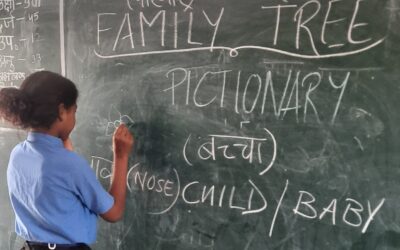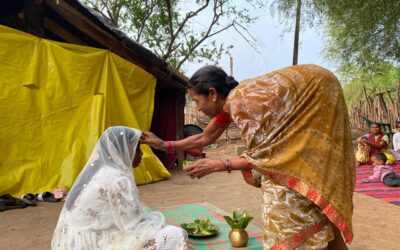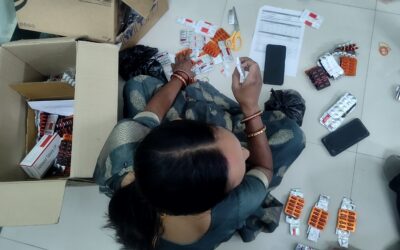Ahmedabad, a bustling town in the western state of Gujarat. It resembles a fast-paced urban city with similar sites of men in white shirts rushing across the streets. Hawkers patiently awaiting customers’ visit. Crowds hovering over the sugarcane juice carts to catch a slight relief from 45 degrees of heat at 10am. The summer was awaiting me here with open arms, as I arrived in the heart of Gujarat to commence my fellowship.
A common sight was that of shops selling coolers and air conditioners. Showcasing them right on the streets to private vehicles with their coolers on and glasses shut tight. The view was distinctively different in the place where I went next. Narrow lanes bedecked with shanty houses, makeshift roofs and alleyways. It felt like a different world in contrast to the bustling urban hub.
This was my first day of field visit. I joined as an India Fellow with Janvikas – a civil society organization working on social transformation and capacity building programmes targeted at minority groups across Gujarat. This article describes a field visit day of one such intervention, Driverben – which aims at training minority women as professional chauffeurs.
Parallel Worlds
As an induction to understanding the program, I accompanied our community mobilizer to the first target area of our program. Right from the moment I entered the Basti Chowk to the moment I boarded the auto for the next target area, the ordeals of survival that I witnessed were humbling. Until some distance, the roadsides were full with common sights of small shops along the roadside. Women sitting on the floor tying bundles of broomsticks together. I later understood from our team mobilizer about the hardships these women face regularly just to attain a bare sustenance.
The dust and husks from the broom often keep sticking in their bodies causing painful rashes and itches, especially in intimate areas. They are paid a meager Rs.8-10 for each finished item.
Witnessing this struggle of survival just a few kilometers inward of a bustling business town kept me wondering about the reality of these ‘profitable businesses’ and how each year they manage to attract people from all over in the hope of better survival. Who is actually getting to reap the benefits of the hard-work done by thousands of people like the community here?

The Kite Makers
the first interaction I had was with a family of two women, mother and daughter who were elated to welcome us inside. As I stepped in, I saw two huge piles of kites, almost reaching up to the ceiling kept at the corner. Inquisitively I asked the daughter about it.
Isi se guzara chalta hai humara (This is how we meet ends)
The lady, somewhere in her early 30s, replied
As we waited for tea, which they offered even after we refused several times, we went on to talk more about the kites. What I discovered made me realize how each of these, seemingly normal-looking kites is a symbol of both creativity, survival and speaks volumes about the resilience of its makers.
Almost every household in this basti had one or two members working in the city hubs or mostly surviving on hand-producing kites and brooms. The raw materials for the kite are provided by the middlemen and after assembling them, the finished products are sold at shops. These people, mostly women, with deft hands stuck frames together and attach the kite’s tail. These kites gets sold at somewhere between ₹5- ₹20. However, sadly, these people receive less than ₹1 for each. The middlemen have contracts with each of them for the production of a thousand kites a day for a mere ₹70-80.
Why Kites?
Kite making is a humongous industry here in Gujarat, and Ahmedabad accounts for the mighty share. In 2019, in a virtue to promote this industry, the government organized an International Kite Festival in Ahmedabad. The statistics show the industry to be of a size of Rs 625 crore, giving employment to 1.3 lakh people. These numbers often leave me wondering about the annotations and terminologies that we consider while gauging such indicators. I wonder what is the nature of such employment when we consider the quality of working conditions and the average pay?
The history of kites and its base in Ahmedabad is very rich and old. Evident by the fact that the city itself houses an entire museum called the Kite Museum of Ahmedabad. But the living proof that I witnessed of the few women and probably hundreds of such others, sketches a sorrowful picture. Nearly 10-12 hours of their day is dedicated to completing each stack of 1000 kites. Leaving them to stay content earning less than a minimal wage. The plight of these kite-makers is emblematic of a larger reality faced by informal female laborers across the country.
Women constitute approximately 70% of the informal labor force in India, yet they often find themselves marginalized and exploited. Lacking access to formal employment opportunities, they are forced to eke out a living through precarious means, such as piece-rate work in industries like kite-making and broom production.
The Intricate Web Of Interconnections
The process of kite-making revealed a simple yet profound narrative. In witnessing the lives of these kite makers, I couldn’t help but reflect on the intricate web of inter-connectedness that binds communities together. Kite-flying forms an integral part of several community festivals. This festival marks a time of thanksgiving for the religious people. It celebrates the gods’ reawakening from their long sleep. The gods, believed to have slept for six months, have now awoken, opening the gateways to heaven. These vibrant hues of kites make a part of the merry-making.
It’s profound to realise what lies beyond these colourful kites that grace the sky during festivals. A silent yet profound story of human endeavour and determination. From a mother striving hard to send her son to school to a single woman bringing food to the table. These kites are in a way helping innumerable families attain a better life for themselves. Although my speculations hold me against considering it as a livelihood generation. I also cannot deny how instrumental it is to give these people hope for a better tomorrow.
For me, the kites of Ahmedabad serve as a poignant reminder of the struggles of everyday life of thousands of people working in the informal sector. Yet the manage to be resilient and hopeful for tomorrow. The question is who is getting to decide their future?




0 Comments